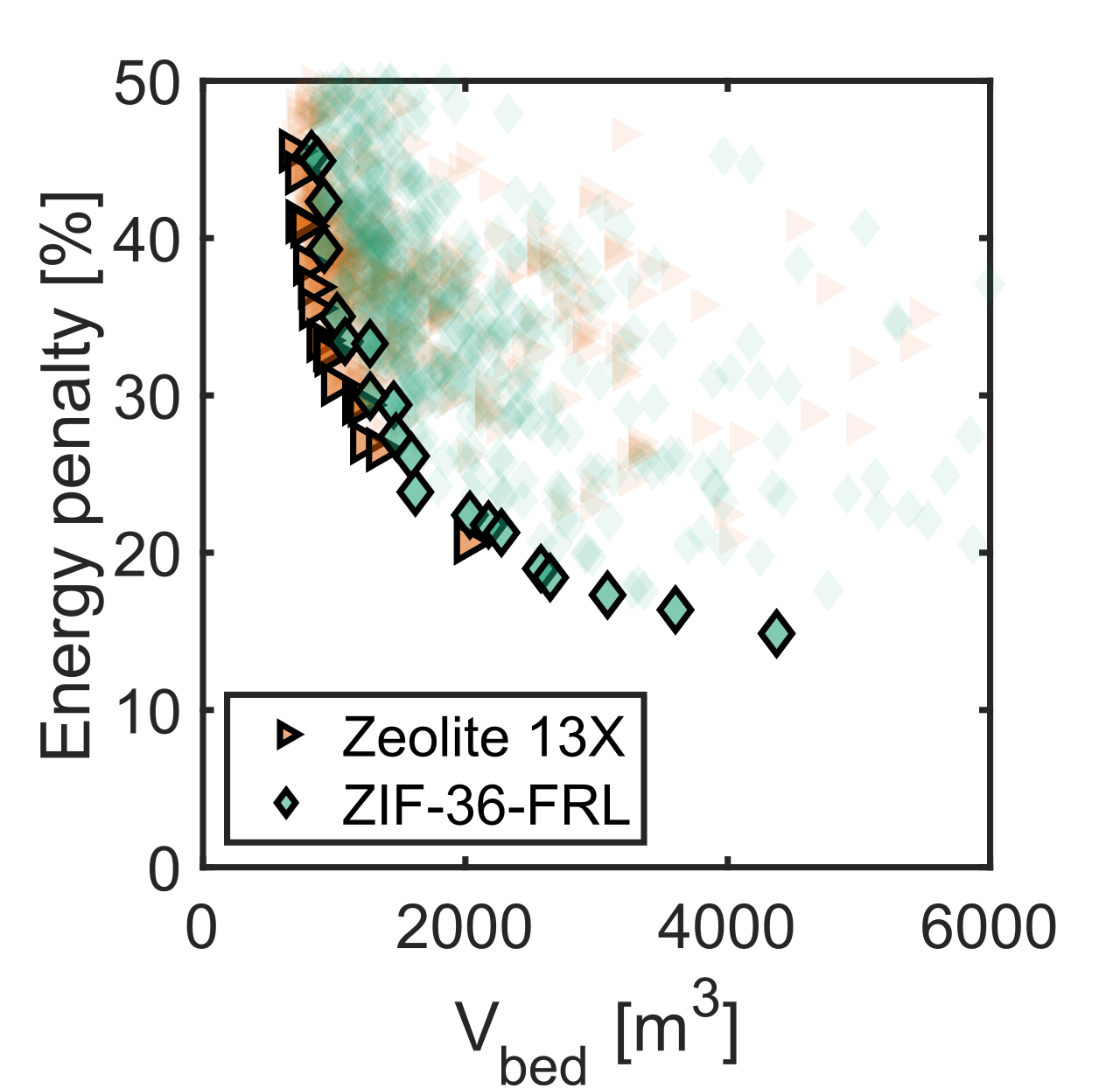Pressure-vacuum swing adsorption (PVSA) processes are a promising candidate technology for the removal of CO
2 from post-combustion flue gases. PVSA processes operate in a series of distinct steps, in each of which the operating pressure is varied to separate CO
2. There are several important operating parameters in these systems which significantly impact the extent of the separation, including the operating pressure and duration of each cycle step, as well as the feed rate of flue gas to the process. The relationship between these operating parameters is highly non-linear, making these processes inherently challenging to design. To search for optimal operating conditions, we must typically consider the multi-objective optimization of two conflicting properties of the system, the productivity and the energy usage. The productivity specifies the amount of CO
2 extracted in the PVSA process per unit bed volume and per unit time. The total energy usage is the amount of energy required by compressors and vacuum pumps to achieve the pressure changes necessary in each cycle step. Because these two objectives conflict with one another, the solution of the process optimization problem is a Pareto front of optimal solutions â each of which represents the best available trade-off between the two objectives. The multi-objective optimization is also constrained by regulatory requirements on the purity and recovery of CO
2 extracted from the flue gas. This frames the design of PVSA processes as a constrained multi-objective optimization problem with a relatively large number of decision variables. When we consider that the evaluation of the process performance indicators for a single operating point using detailed process modelling is very time consuming, we can understand that the optimization workflow is very computationally expensive to evaluate. In our own experience, and with reference to the extensive literature available on the subject, solution for the Pareto front can take on the order of a few days.
There are several emerging trends in the literature of adsorption process design which will only serve to increase the computational complexity of this workflow further. Firstly, there is adsorbent screening, wherein many adsorbent materials need to have their optimal process performance evaluated to search for the best adsorbent material for a given application. Secondly, there are process design problems which incorporate process superstructures. In these problems, the process cycle is tailored as part of the optimization problem to best suit a given adsorbent material to find the ideal material-process combination. Finally, there are applications of alternative adsorption process configurations, such as layered bed adsorbers or beds incorporating structured contactors. In all these important applications, the number of decision variables and/or detailed models which need to be evaluated is much larger than that in the current status-quo, in which we optimize the performance of a fixed cycle with a given adsorbent material. Yet, the optimization problem within the status-quo is still, to date, prohibitively computationally expensive to readily permit an extension to any of the design problems mentioned above. One of the available options to resolve this conflict is to improve the efficiency of the optimization routine with which the detailed model is coupled.
In this work, we demonstrate the application of a so-called surrogate optimization approach for the design of a pressure-vacuum swing adsorption process for post-combustion CO2 capture. Specifically, we consider the Thompson Sampling Efficient Multi-Objective Optimization (TSEMO), which has previously been successfully applied for the design of adsorption processes (Hao et al., 2021). Here, we extend previous applications of the algorithm by considering the important case of purity/recovery constrained productivity-energy usage optimization. We have carried out a post-combustion CO2 capture process design problem to evaluate the performance of a promising metal organic framework material, ZIF-36-FRL, for separating a binary mixture of CO2/N2. Within the process design framework, we employ the TSEMO algorithm to optimize the operating conditions (operating pressures, cycle step durations, feed rate of flue gas) of a four-step PVSA cycle with light product pressurization to obtain a Pareto front of maximum productivity and minimum energy usage. The Pareto front is constrained by requiring both purity and recovery of the extracted CO2 to be in excess of 90%. We have also evaluated the same design problem using the widely adopted non-dominated sorting genetic algorithm II (NSGA-II) as a benchmark.
As can be seen in Fig. 1, ZIF-36-FRL is able to achieve a lower energy penalty than zeolite 13X, a benchmark material for post-combustion capture, when applied in a post-combustion setting to a representative 1,000 MW coal-fired power plant. We have found that in the case of the constrained productivity-energy usage problem, TSEMO can obtain an essentially identical Pareto front to NSGA-II, while reducing the required single-core CPU time by a factor of 15. This result is powerful and exciting, with wide-reaching implications in the adsorption process design literature for both the status-quo of process design â as well as having applicability for the extension to emerging, challenging and novel process design tasks.
References:
Hao et al. (2021): âEfficient hybrid multiobjective optimization of pressure swing adsorptionâ. Chemical Engineering Journal (423). https://doi.org/10.1016/j.cej.2021.130248


